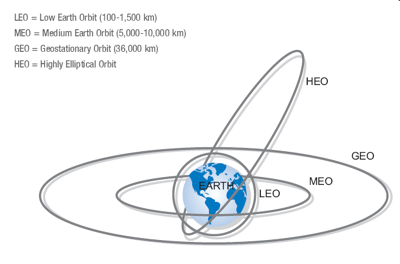
Map showing various orbital levels around Earth.
Orbitals are areas of space around a planet or other large astronomical body. There are three levels of Orbitals: Low Orbitals, Medium Orbitals, and High Orbitals. Each is defined by the speed and orbital period of a naturally circular orbit at that altitude, so the distances involved vary from planet to planet based on the size and mass of the planet, and on its own rotational speed and axial tilt.
Low Orbitals[]
Low orbitals are those low and fast orbits close to the upper atmosphere. They are used when it is desired to make things easy and fuel-efficient for shuttle traveling between orbit and the surface, or when a close-up look is desired for sensors and weapon targeting systems. They are also useful in some tactical scenarios where keeping deep inside a gravity well and being able to quickly duck behind the shelter of a planet are desireable. On Earth, they extend from about 100 kilometers to 1,500 kilometers from the surface. Above this level, the heart of the Inner Van Allen Radiation Belt makes it inadvisable for ships, satellites, or space stations to spend prolonged periods in orbit, even with modern particle shielding. A typical earth-like planet will be circled every one to three hours by an object in low orbit.
Middle Orbitals[]

The Van Allen Radiation belts that divide the three orbital zones around most planets
Middle Orbitals are those higher and slower orbits between the Inner and Outer Van Allen Radiation Belts. Used mainly for defensive platforms, battlestations, and cargo transshipment stations, some planets also have large orbital industrial infrastructure in these levels, if the industry is aimed more at export and interstellar trade than at trade with the surface of the planet below. On Earth, they extend from about 5,000 to 10,000 kilometers in altitude. Below or above this level, radiation levels from the Van Allen belts becomes dangerously high. A typical earthlike planet will be circled every 6 to 12 hours by an object in a middle orbital.
High Orbitals[]
High Orbitals are the highest and slowest orbits, those of Geosynchronous orbit levels and above. A Geosynchronous orbit is one in which the satellite orbits once each planetary day, and thus either seems to hover permanently above one spot on the equator, or oscillate north and south through a narrow band of longitudes if its orbit is tilted relative to the planet's own axis of rotation. Above this, objects actually seem to move backwards along the surface of the planet relative to their orbital motion, because the planet rotates faster than the satellite orbits it. This level is favored for communications satellites, defensive sensor platforms, and long-term parking orbits for defensive starships not planning to go anywhere for a while, such as LAC-1054s. On Earth, these levels extended above about 36,000 kilometers, only ending above 500,000 kilometers around where the Moon used to be before Erich Von Shrakenberg blew it up.
Other Orbits[]
All of the above refers to circular and near-circular orbits only. Highly Eliptical Orbits can cut across all three orbital levels, and are mostly used for tactical maneuvering during battle, or for stealthed weapons and sensor platforms. Polar Orbits are tilted at extreme angles to the planet's own axis of rotation, and are used for surveillance satellites (becuase they will eventually pass over every spot an a planet's surface) or orbital infrastructure on planets where the equatorial zone is uninhabited or uninhabitable for some reason.
Tactical Considerations[]
While space-based defensive installations may be stationed at any orbital level, ground-based defenses tend to only be effective against ships in the low and medium orbitals. This is because missiles coming up from a surface need to fight gravity and air resistance and thus are slow and easy to target with point defense systems; and beam weapons are spread out and attenuated by passage through an atmosphere, and thus are greatly limited in their effective range compared to space-based weapons. On planets with negligible atmospheres, the ability to use the planet and its atmosphere as a heat sink allows much more powerful beam weaponry to have higher rates of fire than on any starship, so beam weapons on such worlds are effective deep into the High Orbitals and beyond. Similarly, ships in the high orbitals have trouble seeing and targeting objects on a planetary surface through its atmosphere and cloud cover, and thus are limited in the accuracy with which they can carry out kinetic interdiction strikes.